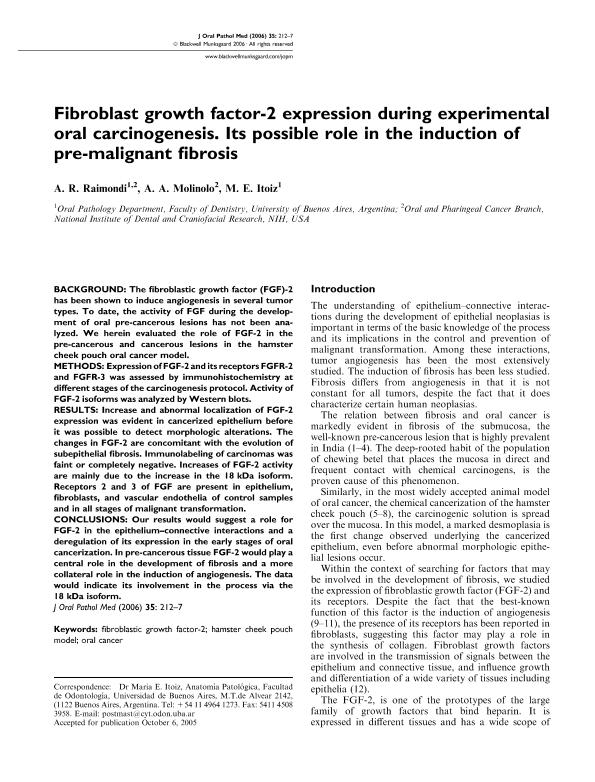Mostrar el registro sencillo del ítem
dc.contributor.author
Raimondi, Ana Rosa

dc.contributor.author
Molinolo, A. A.
dc.contributor.author
Itoiz, Maria Elena
dc.date.available
2020-08-05T15:42:17Z
dc.date.issued
2006-12
dc.identifier.citation
Raimondi, Ana Rosa; Molinolo, A. A.; Itoiz, Maria Elena; Fibroblast growth factor-2 expression during experimental oral carcinogenesis. Its possible role in the induction of premalignant fibrosis; Wiley Blackwell Publishing, Inc; Journal Of Oral Pathology And Medicine; 35; 4; 12-2006; 212-217
dc.identifier.issn
0904-2512
dc.identifier.uri
http://hdl.handle.net/11336/110900
dc.description.abstract
BACKGROUND: The fibroblastic growth factor (FGF)-2 has been shown to induce angiogenesis in several tumor types. To date, the activity of FGF during the development of oral pre-cancerous lesions has not been analyzed. We herein evaluated the role of FGF-2 in the pre-cancerous and cancerous lesions in the hamster cheek pouch oral cancer model. METHODS: Expression of FGF-2 and its receptors FGFR-2 and FGFR-3 was assessed by immunohistochemistry at different stages of the carcinogenesis protocol. Activity of FGF-2 isoforms was analyzed by Western blots. RESULTS: Increase and abnormal localization of FGF-2 expression was evident in cancerized epithelium before it was possible to detect morphologic alterations. The changes in FGF-2 are concomitant with the evolution of subepithelial fibrosis. Immunolabeling of carcinomas was faint or completely negative. Increases of FGF-2 activity are mainly due to the increase in the 18 kDa isoform. Receptors 2 and 3 of FGF are present in epithelium, fibroblasts, and vascular endothelia of control samples and in all stages of malignant transformation. CONCLUSIONS: Our results would suggest a role for FGF-2 in the epithelium-connective interactions and a deregulation of its expression in the early stages of oral cancerization. In pre-cancerous tissue FGF-2 would play a central role in the development of fibrosis and a more collateral role in the induction of angiogenesis. The data would indicate its involvement in the process via the 18 kDa isoform.
dc.format
application/pdf
dc.language.iso
eng
dc.publisher
Wiley Blackwell Publishing, Inc

dc.rights
info:eu-repo/semantics/openAccess
dc.rights.uri
https://creativecommons.org/licenses/by-nc-sa/2.5/ar/
dc.subject.classification
Oncología

dc.subject.classification
Medicina Clínica

dc.subject.classification
CIENCIAS MÉDICAS Y DE LA SALUD

dc.title
Fibroblast growth factor-2 expression during experimental oral carcinogenesis. Its possible role in the induction of premalignant fibrosis
dc.type
info:eu-repo/semantics/article
dc.type
info:ar-repo/semantics/artículo
dc.type
info:eu-repo/semantics/publishedVersion
dc.date.updated
2020-07-21T20:21:13Z
dc.journal.volume
35
dc.journal.number
4
dc.journal.pagination
212-217
dc.journal.pais
Reino Unido

dc.journal.ciudad
Copenhagen
dc.description.fil
Fil: Raimondi, Ana Rosa. Consejo Nacional de Investigaciones Científicas y Técnicas; Argentina. Universidad de Buenos Aires. Facultad de Odontología; Argentina
dc.description.fil
Fil: Molinolo, A. A.. National Institute of Dental and Craniofacial Research; Estados Unidos
dc.description.fil
Fil: Itoiz, Maria Elena. Universidad de Buenos Aires. Facultad de Odontología; Argentina
dc.journal.title
Journal Of Oral Pathology And Medicine

dc.relation.alternativeid
info:eu-repo/semantics/altIdentifier/url/https://pubmed.ncbi.nlm.nih.gov/16519768/
Archivos asociados
